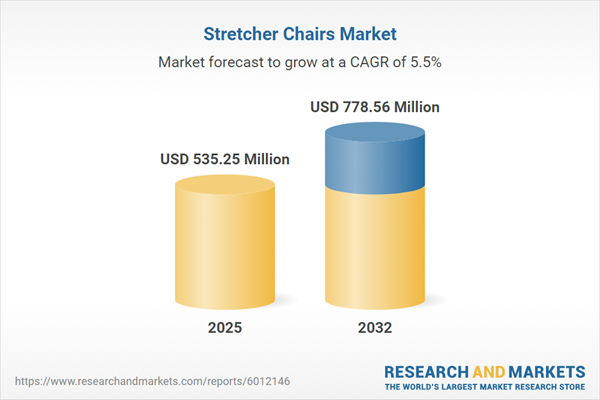Speak directly to the analyst to clarify any post sales queries you may have.
Senior executives recognize that advanced mobility and patient transport solutions, such as stretcher chairs, are integral to enhancing patient care delivery, streamlining operations, and supporting compliance within evolving healthcare environments. Strategically investing in innovative stretcher chair technologies aligns infrastructure with robust safety, performance, and future integrated care requirements.
Market Snapshot: Stretcher Chairs Market Size and Growth
The global stretcher chairs market is valued at USD 506.69 million in 2024 and is expected to reach USD 535.25 million by 2025, reflecting a 5.51% compound annual growth rate (CAGR). Projections indicate the market will reach USD 778.56 million by 2032. This growth is driven by ongoing demand among hospitals, outpatient clinics, emergency services, and home care teams for adaptable, dependable, and durable solutions tailored to diverse care settings. As care models and reimbursement frameworks shift, procurement decisions increasingly favor platforms ensuring seamless infrastructure alignment and high performance over the long term, positioning stretcher chairs as critical components in the mobility equipment segment.
Scope & Segmentation: Stretcher Chairs Market
- Material Options: Aluminum stretcher chairs deliver maneuverability in tight clinical zones. Carbon fiber and composite materials combine strength and lightweight handling for ease of use and deployment. Stainless steel models are engineered for durability and stringent safety compliance across extended service periods.
- Type Variants: Electric stretcher chairs support ergonomic patient positioning and comfort, suitable for advanced care settings. Hydraulic types offer flexible operation for clinical variability. Manual models provide consistent performance at lower acquisition and maintenance costs.
- Distribution Channels: Direct sales channels expedite procurement for large institutions. Regional distributors and specialty retailers meet localized facility requirements. Digital procurement platforms enable efficient inventory oversight and centralized purchasing for facility networks.
- End User Segments: Hospitals, ambulance providers, outpatient facilities, emergency medical services, and home care groups focus procurement on solutions with regulatory compliance, operational adaptability, and scalable deployment potential.
- Application Areas: Stretcher chairs are essential in diagnostic imaging, emergency transport, intra-facility transfers, and perioperative care, contributing to safe patient handling throughout the care continuum.
- Regional Coverage: Market dynamics vary by region. The Americas prioritize logistics reach and equipment versatility. Europe focuses on procurement conformity and regulatory demands. Middle East & Africa emphasize rapid deployment and infrastructure growth. Asia-Pacific is influenced by investment capacity and evolving care standards.
- Leading Companies: Baxter International Inc., Stryker Corporation, Arjo AB, LINET Group SE, Drive DeVilbiss Healthcare LLC, GF Health Products Inc., Medline Industries LP, Paramount Bed Co. Ltd., Direct Supply Inc., and Joerns Healthcare LLC offer extensive logistics support and operational expertise, reinforcing reliability for institutional buyers.
Key Takeaways for Senior Decision-Makers
- Modern ergonomic and modular designs mitigate care team physical strain and simplify patient transfers between multiple care environments, enhancing workflow and safety.
- Lightweight materials facilitate rapid repositioning to meet urgent clinical needs and support smooth adaptation to changes in patient volume or care setting structure.
- Integration of real-time sensors allows continuous asset monitoring and predictive maintenance, which helps maintain high operational uptime and reduces unplanned out-of-service events.
- Advanced power systems and actuators enable reliable use in remote and home care applications, supporting trends in distributed and scalable care delivery models.
- Seamless compatibility with healthcare IT infrastructures fosters compliance, supports robust data protection, and streamlines documentation across care teams and settings.
- Strong supplier relationships, including training and post-purchase technical support, allow health organizations to adapt resources and extend chair lifecycles as market needs shift.
Tariff Impact and Supply Chain Response
Recent U.S. tariffs levied on key stretcher chair components have accelerated industry efforts to diversify supplier bases and establish alternate production locations. To maintain uninterrupted access for institutional buyers, distributors are enhancing inventory strategies and updating contract terms. These adjustments help sustain innovation and secure reliable product availability despite global supply fluctuations.
Methodology & Data Sources
This market evaluation is based on structured interviews with stretcher chair manufacturers, institutional procurement leaders, and clinical end users. Findings are integrated with systematic reviews of product advancements and regulatory trends, providing tailored, actionable intelligence for senior leaders overseeing healthcare operations and sourcing.
Why This Report Matters for Senior Stakeholders
- Enables procurement and leadership teams to assess advanced stretcher chair technologies and implement resilient sourcing strategies adaptable to dynamic regulatory and logistical challenges.
- Offers critical insight for navigating cross-regional compliance and infrastructure investment decisions, supporting scalable mobility infrastructure and sustainable care delivery frameworks.
Conclusion
The stretcher chairs market continues to respond to evolving models of integrated care, regulatory priorities, and operational objectives. Agile procurement and robust supply chain strategies will be central in supporting high standards and effective patient care outcomes for diverse healthcare providers.
Additional Product Information:
- Purchase of this report includes 1 year online access with quarterly updates.
- This report can be updated on request. Please contact our Customer Experience team using the Ask a Question widget on our website.
Table of Contents
3. Executive Summary
4. Market Overview
7. Cumulative Impact of Artificial Intelligence 2025
Companies Mentioned
The companies profiled in this Stretcher Chairs market report include:- Baxter International Inc.
- Stryker Corporation
- Arjo AB
- LINET Group SE
- Drive DeVilbiss Healthcare, LLC
- GF Health Products, Inc.
- Medline Industries, LP
- Paramount Bed Co., Ltd.
- Direct Supply, Inc.
- Joerns Healthcare, LLC
Table Information
| Report Attribute | Details |
|---|---|
| No. of Pages | 182 |
| Published | November 2025 |
| Forecast Period | 2025 - 2032 |
| Estimated Market Value ( USD | $ 535.25 Million |
| Forecasted Market Value ( USD | $ 778.56 Million |
| Compound Annual Growth Rate | 5.5% |
| Regions Covered | Global |
| No. of Companies Mentioned | 11 |









